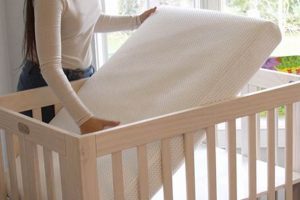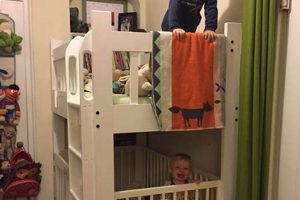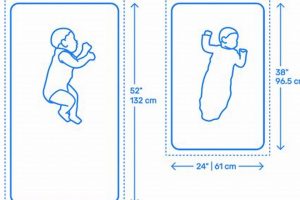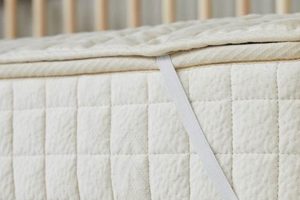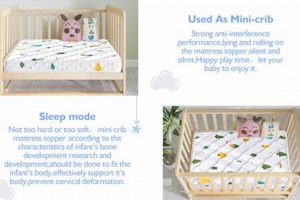A compact sleeping surface designed for smaller-than-standard infant beds, this item provides a firm and supportive area for babies. These mattresses are specifically manufactured to fit the dimensions of mini cribs, which are often chosen for their space-saving qualities or portability.
The use of a correctly sized and appropriately firm sleeping surface is crucial for infant safety and comfort. These products offer a safe alternative to using standard crib mattresses in inappropriately sized cribs, preventing gaps that could pose a hazard. Moreover, the reduced size makes them suitable for smaller nurseries, apartments, or for parents who desire to keep their infant nearby.
This article will delve into the different types of these compact mattresses available, outlining key features to consider when making a purchase, including material composition, safety certifications, and overall construction.
Essential Considerations for Selecting a Compact Crib Mattress
Choosing the correct mattress for a smaller crib requires careful consideration of several factors to ensure infant safety and optimal sleep.
Tip 1: Firmness is paramount. Select a mattress that is demonstrably firm. A soft mattress increases the risk of suffocation.
Tip 2: Verify dimensions. Measure the interior of the mini crib precisely and confirm the mattress dimensions match exactly. Gaps between the mattress and crib sides pose a safety hazard.
Tip 3: Prioritize breathable materials. Opt for mattresses constructed with breathable materials such as cotton or those specifically designed to promote airflow. This reduces the risk of overheating.
Tip 4: Consider waterproof or water-resistant covers. Infant mattresses are susceptible to spills and accidents. A waterproof or water-resistant cover simplifies cleaning and prevents moisture from penetrating the mattress core.
Tip 5: Research Certifications. Look for certifications like GREENGUARD Gold, which indicate the mattress has been tested for chemical emissions and contributes to healthier indoor air quality.
Tip 6: Assess the core construction. Mattresses can be constructed with different core materials, including foam or innerspring. Each offers varying levels of support and durability. Consider the long-term use and desired lifespan of the mattress.
Tip 7: Regularly inspect the mattress. Routinely check the mattress for signs of wear, tears, or sagging. Replace the mattress if any damage is evident.
Selecting the appropriate compact crib mattress necessitates attention to detail and a focus on safety and quality. Proper research and careful consideration of these elements will contribute to a secure and comfortable sleep environment for the infant.
The following sections will provide a deeper understanding of available mattress types and their specific characteristics.
1. Dimensions
The dimensional accuracy of a sleeping surface specifically designed for compact infant beds is of paramount importance. Deviation from specified measurements can compromise safety and render the mattress unusable. Therefore, a precise understanding of dimensional requirements is crucial.
- Length and Width Conformity
The length and width of the mattress must precisely match the interior dimensions of the compact infant bed. A mattress that is too small creates gaps along the sides, posing a risk of entrapment and suffocation. Conversely, a mattress that is too large will not fit properly, potentially damaging the crib structure and creating an uneven sleep surface. Accurate measurement and verification of the products stated dimensions are essential.
- Thickness Specifications
Mattress thickness is another critical dimension. While a thicker mattress might appear more comfortable, excessive thickness can reduce the height of the crib rails, potentially enabling a child to climb out. Most compact cribs adhere to safety standards that dictate the maximum allowable mattress thickness. Exceeding this limit can negate the safety features of the crib.
- Dimensional Stability Over Time
The dimensional stability of the mattress refers to its ability to maintain its original shape and size over time. Inferior materials or construction can lead to sagging, compression, or warping, altering the initial dimensions. Such changes can compromise the intended fit and create unsafe sleep conditions. Selecting a mattress made with durable materials is vital to ensure long-term dimensional integrity.
- Impact of Sheet Fit on Perceived Dimensions
While not a dimension of the mattress itself, the fit of the crib sheet directly interacts with the effective surface area. Sheets that are too loose can bunch up, creating a suffocation hazard. Sheets that are too tight can compress the mattress, altering its firmness and potentially damaging its structure. Choosing sheets specifically designed for compact infant mattresses ensures a proper and safe fit, complementing the mattress’s designed dimensions.
In summation, the correct selection based on precise measurements, combined with a consideration of long-term dimensional stability and appropriate sheet fit, is essential for ensuring a safe and effective sleep environment when utilizing a specialized mattress for compact infant beds. Neglecting these dimensional considerations can lead to significant safety risks.
2. Firmness
In the context of a sleeping surface designed for compact infant beds, firmness is not merely a comfort preference but a critical safety parameter. The link between mattress firmness and infant safety is well-established; a surface that is too soft presents a significant suffocation hazard. Infants lack the motor skills necessary to reposition themselves if their face becomes pressed against a yielding surface, making a firm mattress a preventative measure against Sudden Infant Death Syndrome (SIDS) and other breathing-related risks. The specialized design of a compact sleeping surface accentuates this requirement, as the limited space provides less room for movement and accidental repositioning onto a soft surface.
The selection of materials directly influences mattress firmness. High-density foam and innerspring construction are common choices, both offering different levels of support. However, simply selecting one of these materials does not guarantee adequate firmness. The density and compression rate of the foam, or the gauge and coil count of the innerspring system, must meet specific standards to ensure the mattress provides the necessary level of resistance. Real-life examples of compromised infant safety often involve mattresses that, while marketed as suitable for infants, lacked the requisite firmness due to substandard materials or construction. Regular inspection of the mattress to ensure it maintains its intended firmness is equally crucial, as gradual compression over time can diminish its safety effectiveness. Manufacturers should adhere to specific firmness guidelines to help maintain safety.
The practical significance of understanding the firmness requirement for compact sleeping surfaces lies in its direct impact on infant well-being. While softer surfaces might seem more appealing from a comfort perspective, prioritizing firmness is non-negotiable. Challenges can arise from misleading marketing claims or a lack of clear labeling regarding firmness levels. Therefore, caregivers must exercise due diligence in researching and verifying the firmness of a compact infant mattress before purchase and consistently monitor its condition throughout its use. This diligence is paramount in ensuring a safe sleep environment for the infant.
3. Materials
The selection of materials in a compact infant sleeping surface directly impacts safety, hygiene, and overall suitability for infant use. Material choices influence factors ranging from breathability and chemical exposure to durability and ease of cleaning. Understanding the implications of different material compositions is crucial for making an informed purchase.
- Foam Density and Composition
Foam, often used in compact infant mattresses, varies significantly in density and chemical composition. Higher density foams offer better support and durability but can restrict airflow. The presence of volatile organic compounds (VOCs) in some foams poses a potential health risk. Certifications like GREENGUARD Gold indicate testing for VOC emissions. Real-life examples include instances where infants exposed to high VOC levels experienced respiratory irritation. The type of foam and its certification status is, therefore, a primary consideration.
- Innerspring Coil Type and Count
Innerspring mattresses utilize coils to provide support. The type of coil (e.g., Bonnell, pocketed) and the coil count influence firmness and weight distribution. Higher coil counts generally correlate with increased support and reduced motion transfer. The gauge (thickness) of the steel used in the coils affects durability. Inadequate coil support can lead to sagging, compromising infant safety. Therefore, coil specifications warrant careful examination.
- Cover Fabric Properties
The cover fabric is the outermost layer of the mattress and interacts directly with the infant. Breathability, moisture resistance, and hypoallergenic properties are desirable. Common materials include cotton, polyester blends, and specialized fabrics with waterproof coatings. Non-breathable covers can increase the risk of overheating, while easily soiled fabrics can harbor bacteria. The choice of cover fabric should balance comfort, hygiene, and safety considerations.
- Fire Retardant Treatments
Federal regulations mandate that mattresses meet flammability standards. This is often achieved through chemical fire retardant treatments or the use of inherently fire-resistant materials. The safety and potential health effects of chemical fire retardants are a subject of ongoing debate. Some manufacturers opt for alternative, less controversial methods, such as using wool as a natural fire barrier. Identifying the type of fire retardant treatment used is important for informed decision-making.
These material-related aspects of compact sleeping surfaces should be carefully reviewed to ensure the chosen product aligns with safety standards and minimizes potential risks to infant health. Consideration of these factors is crucial in selecting a safe and comfortable sleep surface.
4. Certifications
Certifications serve as independent verification that a compact crib mattress meets specific safety, performance, and environmental standards. Given the vulnerability of infants and the limited space within compact cribs, adherence to these standards is paramount. Certifications provide an objective measure of quality, offering assurance to caregivers.
- GREENGUARD Gold Certification
This certification indicates that the mattress has been tested for chemical emissions, including volatile organic compounds (VOCs), phthalates, and formaldehyde. These chemicals can off-gas from materials and potentially pose respiratory or developmental risks to infants. A real-life example would be a family choosing a GREENGUARD Gold certified mattress to minimize their baby’s exposure to potentially harmful chemicals, especially crucial in the confined space of a mini crib. This certification ensures healthier indoor air quality.
- CertiPUR-US Certification
This program certifies that the foam used in the mattress has been tested and found to be free from ozone depleters, heavy metals, certain flame retardants, and phthalates. It also tests for low VOC emissions. This is important since infants spend a significant amount of time in direct contact with the mattress. An instance of CertiPUR-US relevance is when parents seek to avoid potentially toxic substances in their child’s sleep environment, ensuring that the foam components meet stringent chemical safety standards.
- JPMA Certification
The Juvenile Products Manufacturers Association (JPMA) certification signifies that the mattress meets or exceeds safety standards established by ASTM International. These standards cover aspects such as firmness, dimensional accuracy, and flammability. JPMA certification provides assurance that the mattress has been independently tested to minimize risks of suffocation, entrapment, and fire. For example, a parent choosing a JPMA-certified mattress can be confident that it has undergone rigorous safety testing.
- OEKO-TEX Standard 100 Certification
This certification verifies that all components of the mattress, including fabrics, threads, and fillings, have been tested for harmful substances. It focuses on limiting the use of chemicals known to be detrimental to human health. A scenario where this certification is relevant is when parents want to ensure that the textiles used in the mattress are free from potentially irritating or allergenic substances, safeguarding their infant’s sensitive skin.
In conclusion, the presence of recognized certifications on a compact crib mattress provides a valuable indicator of product safety and quality. These certifications address key concerns related to chemical emissions, material composition, and adherence to established safety standards. Caregivers should prioritize mattresses with relevant certifications to ensure a safe and healthy sleep environment for their infant. Neglecting to consider certifications increases the risk of exposing the child to hazards such as harmful chemicals or unsafe structural features.
5. Durability
Durability, as a characteristic of a compact infant bed mattress, signifies its capacity to withstand prolonged use and maintain its structural integrity over time. This is particularly relevant due to the frequency of use and potential exposure to spills and other forms of wear and tear. A durable mattress ensures continued safety and support for the infant throughout its intended lifespan.
- Material Resistance to Compression
The ability of the mattress core material (foam or innerspring) to resist permanent compression is a crucial aspect of durability. Over time, repeated pressure can cause the mattress to sag, reducing its support and potentially creating unsafe sleeping conditions. For example, a mattress with low-density foam may compress quickly, leading to an uneven sleeping surface and increased risk of the infant rolling into an unsafe position. High-density foam or robust innerspring systems offer greater resistance to compression and maintain a level sleeping surface longer.
- Cover Fabric Strength and Resilience
The outer fabric covering the mattress is subject to friction, abrasion, and potential staining. A durable cover material will resist tearing, pilling, and degradation from cleaning. A weak or easily damaged cover can expose the inner mattress core, compromising hygiene and potentially releasing harmful particles. Real-world examples include covers made from tightly woven, high-thread-count fabrics that resist wear and tear and can withstand repeated cleaning without losing their integrity.
- Seam and Edge Construction Integrity
The seams and edges of the mattress are vulnerable points of stress and potential failure. Weakly constructed seams can split, exposing the inner core and creating a safety hazard. Reinforced edges help maintain the mattress’s shape and prevent sagging along the sides. A durable mattress will feature robust stitching and reinforced edges to withstand the stresses of use and maintain its structural integrity.
- Resistance to Moisture and Mold Growth
Infant mattresses are prone to spills and accidents, making moisture resistance an important factor in durability. A mattress that readily absorbs moisture can become a breeding ground for mold and bacteria, compromising hygiene and potentially causing health problems. Waterproof or water-resistant covers, combined with breathable core materials, can help prevent moisture penetration and inhibit mold growth, extending the lifespan of the mattress and maintaining a sanitary sleep environment.
In summary, the durability of a sleeping surface designed for a compact infant bed encompasses its resistance to compression, the strength of its cover fabric, the integrity of its seams and edges, and its ability to resist moisture and mold. These factors contribute to the mattress’s overall longevity, safety, and hygiene, ensuring a reliable and healthy sleep environment for the infant. Prioritizing durability in mattress selection mitigates risks associated with wear and tear, promoting long-term value and infant well-being.
Frequently Asked Questions About Compact Crib Mattresses
This section addresses common inquiries regarding compact sleeping surfaces, providing clear and concise answers to assist in informed decision-making.
Question 1: Are compact crib mattresses safe for overnight sleep?
When manufactured to meet established safety standards and used appropriately within a compatible compact crib, these mattresses are suitable for overnight sleep. Key factors include proper fit, firmness, and adherence to safety certifications. Continual monitoring of the mattress’s condition and the infant’s sleep environment is essential.
Question 2: How often should a compact crib mattress be replaced?
The lifespan depends on usage, material quality, and overall condition. A mattress exhibiting signs of sagging, tears, or significant wear should be replaced immediately. Even without visible damage, replacing the mattress after two to three years is advisable to ensure optimal support and hygiene. Consider manufacturer’s recommendations.
Question 3: What is the best way to clean a compact crib mattress?
Refer to the manufacturer’s cleaning instructions. Generally, spot cleaning with a mild detergent and water is recommended. Avoid harsh chemicals or excessive moisture. A waterproof mattress protector can minimize the need for frequent cleaning. Ensure the mattress is completely dry before reuse.
Question 4: Can standard crib sheets be used on a compact crib mattress?
Standard crib sheets are not designed to fit compact mattresses. Using oversized sheets can create a loose fit, posing a suffocation hazard. Only use sheets specifically designed for compact crib mattresses to ensure a snug and secure fit.
Question 5: What firmness level is recommended for a compact crib mattress?
A firm mattress is crucial for infant safety. Soft mattresses can increase the risk of suffocation. The mattress should resist indentation when pressed. Consult product descriptions and reviews to assess firmness levels. Firmness is non-negotiable and ensures that it meets all safety firmness guidelines.
Question 6: Are organic compact crib mattresses worth the investment?
Organic mattresses utilize materials grown without synthetic pesticides or fertilizers, reducing exposure to potentially harmful chemicals. Whether the investment is justified depends on individual priorities and budget. However, the potential benefits of reduced chemical exposure warrant consideration, particularly for infants with sensitivities or allergies.
In summary, selecting the correct size and prioritizing firmness are paramount to the safe sleep environment.
The following section will provide information on how to buy it.
Delta Mini Crib Mattress
The preceding exploration of the compact sleep surface designed for Delta mini cribs highlights critical factors impacting infant safety and well-being. Dimensions, firmness, materials, certifications, and durability are not merely features but essential safeguards. Neglecting any of these aspects compromises the integrity of the sleep environment and increases potential risks.
The selection of a Delta mini crib mattress demands careful attention to detail and a commitment to prioritizing infant safety above all else. Future advancements in material science and manufacturing processes may further enhance the safety and comfort of these products; however, a thorough understanding of current best practices remains paramount for all caregivers.


